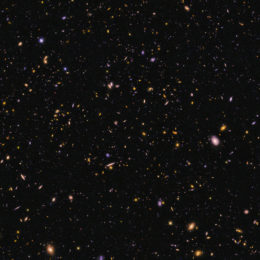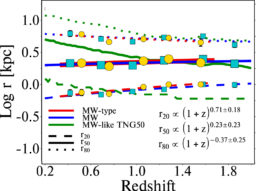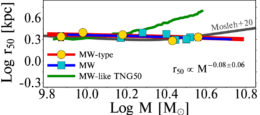Milky Way–like galaxies are abundant in the universe. A recent publication scours astronomical surveys to understand how these familiar spirals grow over billions of years.
How Does Your Galaxy Grow?

A field of galaxies from the Cosmic Assembly Near-infrared Deep Extragalactic Legacy Survey. Click to enlarge. [NASA, ESA, P. Oesch and I. Momcheva (Yale University), and the 3D-HST and HUDF09/XDF Teams]
In a recent study, a team led by Maryam Hasheminia (Shiraz University and Institute for Advanced Studies in Basic Sciences) turned to survey data to understand how the Milky Way and galaxies like it grew into the galaxies they are today.

Size evolution of Milky Way–like galaxies selected using the first method (red), the second method (blue), and from cosmological simulations (green). The quantities r20, r50, and r80 are the radii within which 20%, 50%, and 80% of the galaxies’ stellar mass is contained, respectively. [Adapted from Hasheminia et al. 2022]
Looking for Lookalikes
When we observe galaxies as they existed billions of years ago, how do we know which galaxies will grow to look like the Milky Way? Hasheminia and collaborators used two methods to pick Milky Way–like galaxies out of the Cosmic Assembly Near-infrared Deep Extragalactic Legacy Survey (CANDELS) and the 3D-Hubble Space Telescope survey.
In the first method, the team assumed that Milky Way–type galaxies follow the observed relationship between galactic stellar mass and star formation rate for galaxies that are actively forming stars, and the authors selected galaxies out of the survey data that followed that relation. In the second method, the team matched the stellar masses and ages of galaxies in the survey data to the stellar growth history of the Milky Way as derived from chemical evolution models.
Self-Similar Growth

Evolution of the half-mass radius (r50) of Milky Way–like galaxies with increasing stellar mass. [Adapted from Hasheminia et al. 2022]
The results indicate that all parts of these galaxies gain stellar mass at a similar rate. This contrasts with the hypothesis of inside-out growth, in which star formation ramps up in the center of a galaxy first before spreading to the outer regions, as well as the results of cosmological simulations; simulations matched the team’s findings early in the history of the universe, but they diverged around 6 billion years ago.
The team suggests that their findings are consistent with previous Milky Way evolution scenarios, in which a thick disk of stars formed when the universe was about 6 billion years old, before star formation stalled and a bar of stars formed in the center of the galaxy. To fully unravel the growth history of the Milky Way and galaxies like it, we’ll need high-resolution observations of galaxies in the distant past — and with JWST, such observations are in our future!
Citation
“No Evolution in the Half-mass Radius of Milky Way–type Galaxies over the Last 10 Gyr,” Maryam Hasheminia et al 2022 ApJL 932 L23. doi:10.3847/2041-8213/ac76c8
